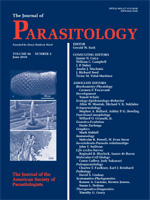The antigenic profile and infectivity were compared between 3 recent Leishmania (Viannia) isolates from the Amazonian region (Instituto Nacional de Pesquisas da Amazonia [INPA] strains) and 3 World Health Organization (WHO) reference species (Leishmania guyanensis, Leishmania braziliensis, and Leishmania naiffi). Differences were observed in the peak and extent of promastigote growth. The WHO reference strains exhibited significantly higher exponential growth as promastigotes than INPA strains. In the immunoblot analyses, the INPA strains revealed several specific peptide fragments, as well as the greatest recognition frequencies by sera from Leishmania sp.–infected patients; among the latter, antigens derived from L. naiffi were the most frequently recognized. In vitro infection was carried out using mice peritoneal macrophages; all strains were able to enter the macrophages, but only L. amazonensis was able to reproduce. A striking observation was that L. naiffi exhibited the longest survival time inside the macrophages. Our data strongly suggest the application of recently isolated parasites as sources of antigen for diagnosis procedures. Moreover, L. naiffi species possesses several characteristics relevant for its use as a source of novel antigens to be explored in the design of diagnostic tools and vaccines.
How to translate text using browser tools
1 June 2010
Differences in the Antigenic Profile and Infectivity of Murine Macrophages of Leishmania (Viannia) Parasites
Nubia E. Matta,
Lea Cysne-Finkelstein,
Gerzia Maria C. Machado,
Alda Maria Da-Cruz,
Leonor Leon
ACCESS THE FULL ARTICLE

Journal of Parasitology
Vol. 96 • No. 3
June 2010
Vol. 96 • No. 3
June 2010




